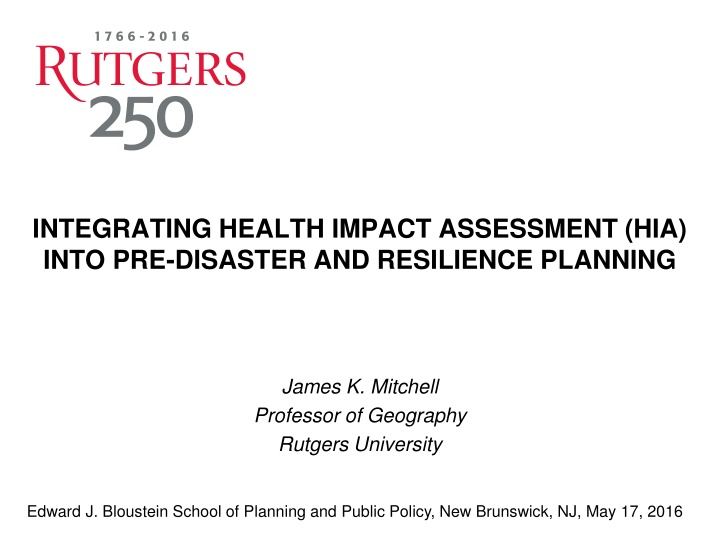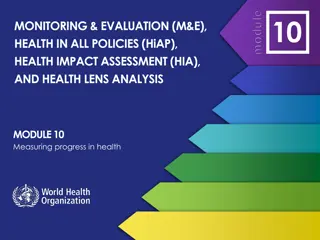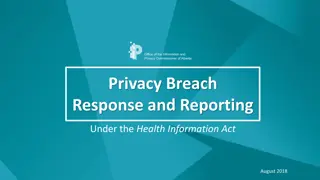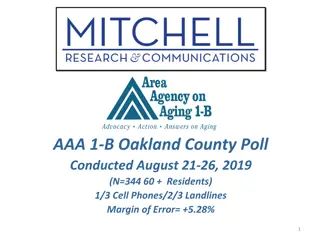
Integrating Health Impact Assessment (HIA) into Disaster Resilience Planning
Explore the importance of integrating Health Impact Assessment (HIA) into pre-disaster and resilience planning to address immediate and long-term health impacts of disasters. The post-disaster recovery problems are analyzed, emphasizing the need for improved health assessments and sustainable recovery measures to enhance hazard resilience.
Download Presentation

Please find below an Image/Link to download the presentation.
The content on the website is provided AS IS for your information and personal use only. It may not be sold, licensed, or shared on other websites without obtaining consent from the author. If you encounter any issues during the download, it is possible that the publisher has removed the file from their server.
You are allowed to download the files provided on this website for personal or commercial use, subject to the condition that they are used lawfully. All files are the property of their respective owners.
The content on the website is provided AS IS for your information and personal use only. It may not be sold, licensed, or shared on other websites without obtaining consent from the author.
E N D
Presentation Transcript
INTEGRATING HEALTH IMPACT ASSESSMENT (HIA) INTO PRE-DISASTER AND RESILIENCE PLANNING James K. Mitchell Professor of Geography Rutgers University Edward J. Bloustein School of Planning and Public Policy, New Brunswick, NJ, May 17, 2016
HIA Recommendations HEALTH IMPACTS OF DISASTERS IMMEDIATE CLEAN-UP DELAYED (long term) Injuries Accidents Mental health problems* Allergies Dehydration Stress-related disorders* Disease outbreaks Heat Exhaustion Nutritional diseases Diarrheal diseases Allergic reactions Respiratory conditions Asthma exacerbation Hypothermia Poisoning * e.g. PTSD, substance abuse, anxiety, depression, suicide, isolation/anomie. RECOVERY HEALTH ISSUES (examples) Slower recovery of disadvantaged vulnerable groups Elevated housing increases problems for elderly Changes in access to nutritious food sources affects obesity/diabetes Relocation may damage social support networks
HIA Recommendations POST-DISASTER RECOVERY PROBLEMS Recovery is a weak component of hazard management Slow, piecemeal, bewildering, contentious, marked by disconnects between decision makers and affected publics Reproduces existing vulnerabilities Typically neglects mitigation Without major improvements losses are likely to accelerate Worsening physical risks Widening vulnerability gaps Emerging new kinds of vulnerabilities Health Impact Assessments are a promising innovation with potentially large benefits Improved health for people in disaster impacted communities Sustainable disaster recovery measures that add to hazard resilience
HIA Recommendations DISASTER DIMENSIONS OF EXISTING HIAs 350+ ongoing/completed HIAs (mid-2015) A few HIAs make recommendations that strengthen short-term responses Emergency Preparedness Plan (Billings, MT) Denial of permit for facility that hindered emergency evacuation (Bernalillo County, NM) Rejection of county plan that hindered emergency evacuation (Merced County, CA) But natural hazards are generally not included Hermosa Beach, CA oil drilling project omitted climate change risks Coachella Valley, CA omitted flood risks to proposed developments C.20 HIAs address natural hazard reduction directly; most focus on mitigation of chronic low intensity problems (e.g. routine flooding)
GOAL HIA LOCATION LINKAGE TO DISASTER REDUCTION HIA Recommendations Recovery Galveston, TX Replacement of housing destroyed by hurricane Ike Recovery Little Egg Harbor, NJ Buyout scenarios for properties affected by hurricane Sandy Post-Sandy comprehensive storm water management plan Dredging and sewer projects in chronically flood prone area Recovery Hoboken, NJ Mitigation Cana Martin, PR Mitigation Proctor Creek, Atlanta, GA Green infrastructure in chronically flood prone area Mitigation Cole Creek, Omaha, NE Use of vacant lots created by flood buyouts & erosion control Mitigation Ann Arbor, MI Urban forestry as aid to high temperature reduction Mitigation Delaware County, OH Storm water runoff control from new shopping mall Mitigation Marin County, CA Housing code enforcement in poor drainage area Mitigation Rochester, NY Changes in lakefront storm water management Mitigation Chicago, IL Smart power cutoffs to elderly during cold/heat extremes Mitigation Placer County, CA Healthy forest management for reduction of wildfire risk Mitigation Greenville, WI Ground water contamination from hazardous material storage Mitigation Fitchburg, WI Flood reduction in vicinity of golf course Mitigation State of Kentucky Clean energy in mined area subject to landslides and floods Mitigation State of California Drinking water alternatives in drought affected areas
HIA Recommendations Making Healthier Decisions about Disaster Recovery: Opportunities for the use of Health Impact Assessments What is already known about disaster-related HIAs? Literature review (Appendix) Institutional readiness for employing disaster recovery HIAs HHS, FEMA, HUD, EPA, other federal agencies State and local governments Advocacy Groups Expert opinions: Thought leader perspectives HHS Workshop (March 2015) HIA Thought Leaders Meeting (June 2015) Natural Hazards Workshop (July 2015) HIA case studies in New Jersey Hoboken & Little Egg Harbor Recommendations
HIA Recommendations A GOOD TOOL CAN BE EVEN BETTER The process of Health Impact Assessment needs no fundamental changes to make it useful in support of disaster recovery policies, plans and projects It would benefit from a combination of modifications to make it more appropriately fitted for that purpose.
HIA Recommendations 1. AWARENESS Publicize HIAs among target user groups in communities of hazard and health professionals that have responsibilities, skills and/or interests in disaster recovery and resilience planning.
HIA Recommendations 2. PIVOTS OF APPLICATION Insert HIAs into the disaster recovery decision-making system at key points. National and regional, area-wide decisions Federal and State Task Force rebuilding strategies NFIP regulations FEMA Public Assistance Program Hazard Mitigation Plans Community Development Block Grants NOAA Coastal Resilience Grants Climate Adaptation plans Energy Plans Local, site-specific decisions Construction permits Protective structures Open space acquisition Land use and facility use changes
HIA Recommendations 3. APPRAISAL OF RECOVERY ALTERNATIVES Conduct a systematic analysis of the health impacts of the full range of disaster recovery alternatives, to provide a databank of information about their comparative health outcomes and other consequences.
HIA Recommendations A TWO-STAGE HIA STAGE TWO STAGE ONE Conduct HIAs that incorporate Stage One results, with minimum standards for community involvement and technical assistance. Identify common post-disaster decisions that have the greatest potential to affect health. Prepare programmatic HIA-informed analyses of alternative recovery actions at these points. Support their use in formal decisions about pre- disaster planning and post-disaster recovery with appropriate incentives and/or mandates.
HIA Recommendations 4. GUIDANCE FOR CHOOSING AMONG HIAS Provide decision-makers and HIA users with better guidance for choosing among different kinds of HIAs in post-disaster contexts. Desktop, Rapid, Comprehensive, Programmatic
HIA Recommendations 5: GRASSROOTS TECHNICAL SUPPORT Provide appropriate technical support for local advocacy groups that seek to use HIAs for the joint reduction of health inequities and disaster vulnerabilities.
HIA Recommendations 6: BROADENING AND INTEGRATION Encourage research organizations to develop methods for integrating health impact assessments with economic assessments and environmental impact assessments.






















